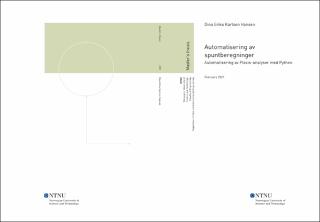| dc.contributor.advisor | Eiksund, Gudmund Reidar | |
| dc.contributor.advisor | Renström, Viktor | |
| dc.contributor.author | Hansen, Dina Erika Karlsen | |
| dc.date.accessioned | 2021-09-20T16:27:07Z | |
| dc.date.available | 2021-09-20T16:27:07Z | |
| dc.date.issued | 2021 | |
| dc.identifier | no.ntnu:inspera:67647919:18041369 | |
| dc.identifier.uri | https://hdl.handle.net/11250/2779524 | |
| dc.description.abstract | Plaxis remote scripting er et programmeringsgrensesnitt som gjør det mulig å styre Plaxis Input og Output ved hjelp av standardiserte kommandoer i programmeringsspråket Python. Når Plaxis styres med Python-kommandoer kan analyser i programmet automatiseres, noe som åpner nye muligheter for optimering og automatisering av repetitive oppgaver i programmet. Hovedmålet for denne masteroppgaven er å utarbeide et Python script som er et steg mot å automatisere dimensjonering av spuntvegger i Plaxis. For å lage et slik script må dimensjonering av en spuntvegg brytes ned i mindre steg som kan automatiseres med Python-kommandoer.
I starten av oppgaven presenteres prinsipper for spuntdimensjonering. Deretter følger et kapittel som omhandler Python og sentrale konsepter i programmeringsspråket. Videre blir fordeler, ulemper og bruksområder for Plaxis remote scripting belyst, og det gis en innføring i ulike hjelpemidler som kan brukes for å skrive Python-kommandoer til Plaxis.
Hoveddelen i oppgaven er en beskrivelse av scriptet i oppgaven. Scriptet kjører spuntanalyser i Plaxis med varierende jordmaterialer, gravedybder og spuntprofiler ved hjelp av en nøstet for-løkke. Når scriptet kjøres begynner for-løkka. En modell med en utkraget spuntvegg og beregningsfaser blir opprettet, og beregninger for modellen utføres. Dersom kravet til sikkerhetsfaktor er oppfylt reduseres spuntlengden med en meter, og beregningene utføres på nytt. Når spuntveggen ikke lenger oppfyller krav til sikkerhetsfaktor blir det satt inn et løsmassestag i modellen. Analysen for spuntvegg med stag blir så utført, og spuntlengden reduseres med en meter dersom sikkerhetsfaktoren tillater det. Når spuntkonstruksjonen ikke lenger oppfyller krav til sikkerhetsfaktor avsluttes analysen. Når scriptet er kjørt skrives resultater til et regneark i Microsoft Excel.
Python-koden er delt inn i ulike script- og modulfiler for å gjøre den oversiktlig, og for å gjøre det lettere å gjenbruke funksjoner i modulene. For å teste scriptet var det nødvendig å velge input-parametere for jordmaterialer, spuntprofiler og gravedybde. Scriptet ble kjørt med tre ulike Hardening Soil-materialer, seks spuntprofiler og syv gravedybder. Scriptet ble kjørt uten problemer med disse variasjonene, men dersom input-data i analysene endres kan det bli nødvendig å tilpasse koden.
Scriptet i oppgaven har flere begrensninger, og mye arbeid gjenstår før scriptet kan brukes til spuntdimensjonering. Forslag til videre arbeid med scriptet er presentert i slutten av oppgaven. | |
| dc.description.abstract | Plaxis remote scripting is an application programming interface (API) that allows the user to control Plaxis Input and Output with Python commands. This makes it possible to automate analyses in Plaxis creating opportunities to optimize designs and automate repetitive tasks. In this thesis a Python script was developed which executes calculations for sheet pile walls in Plaxis. This script is a step towards automating the design of sheet pile walls in Plaxis.
Principles for designing sheet pile walls are presented in the beginning of the thesis. Then follows a chapter about the programming language Python, and an introduction to some important concepts in Python. Then pros, cons, and applications of Plaxis remote scripting are presented along with a list of tools that can be used when writing Python commands for Plaxis.
The main goal of this thesis is to develop a Python script which optimizes the design of sheet pile walls. This script divides the process of designing a sheet pile wall into steps that can be automated with Python commands. The code is divided into several Python files in order to give the code a good structure, and to make it easier to reuse functions that are defined within the modules. The results from the Plaxis analyses that are run by the script are written to Excel-files after the script is executed.
A nested for-loop in the script is used to run sheet pile wall calculations with different soil materials, excavation depths and sheet pile wall profiles. When the execution of the script starts the for-loop begins, and an analysis of a sheet pile wall without anchor will be run. If the specified safety factor is fulfilled, the length of the wall will be shortened by one meter, and the phases will be calculated again. This continues until the safety factor does not fulfil the requirement and a fixed end anchor will be added to the model. New phases will be created and calculated. The wall will be shortened by one meter if the safety factor meets the requirement and the phases will be calculated again. When the sheet pile wall no longer meets the required safety factor the analysis will end.
To test the script during development, it was necessary to determine input-parameters for materials and geometry for the model. The script is tested with three different Hardening Soil materials, six types of sheet profiles and excavation depths between four and ten meters. The script does not necessarily work for all types of materials, and unforeseen problems can occur if input-data in the script is changed.
The script has several limitations and there is work to be done to make the script more robust before the script can be used when designing sheet pile walls. Further work with the script is described at the end of the thesis. | |
| dc.language | nob | |
| dc.publisher | NTNU | |
| dc.title | Automatisering av spuntberegninger | |
| dc.type | Master thesis | |
